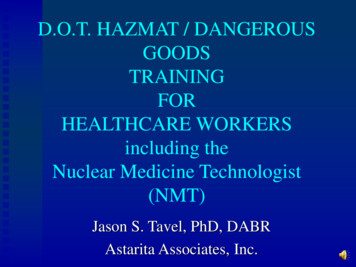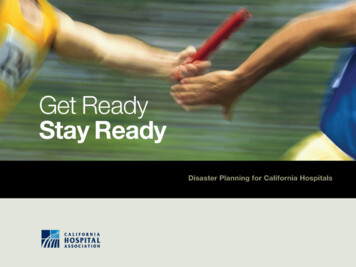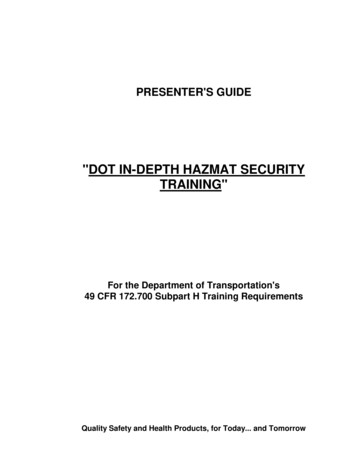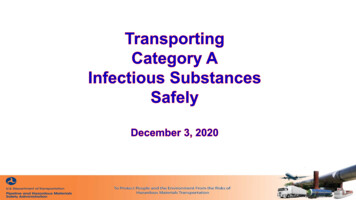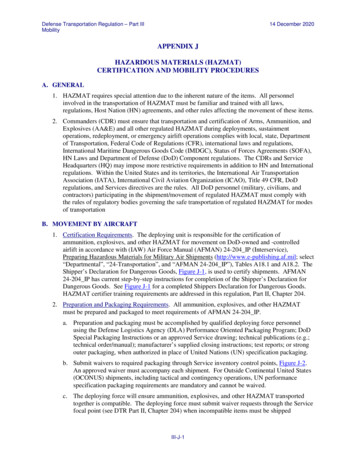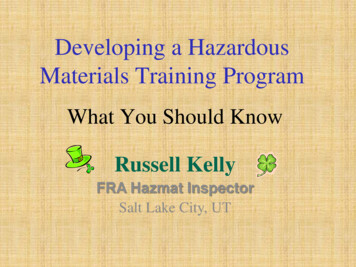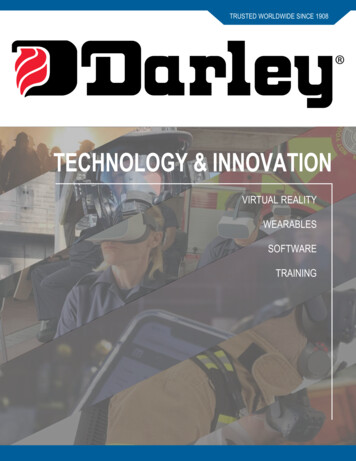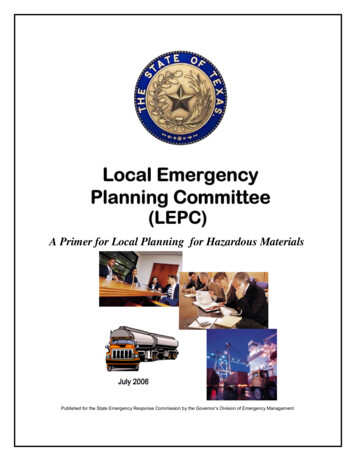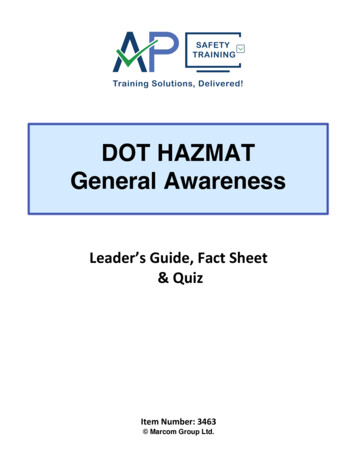
Transcription
DOT HAZMATGeneral AwarenessLeader’s Guide, Fact Sheet& QuizItem Number: 3463 Marcom Group Ltd.
This easy-to-use Leader’s Guide is provided to assist in conducting a successful presentation.PREPARING FOR THE MEETINGHere are a few suggestions for using this program:a) Review the contents of the Fact Sheet that immediately follows this page to familiarize yourself with theprogram topic and the training points discussed in the program. The Fact Sheet also includes a list ofProgram Objectives that details the information that participants should learn from watching theprogram.b) If required by your organization, make an attendance record to be signed by each participant todocument the training to be conducted.c) Prepare the area and equipment to be used for the training. Make sure the watching environment iscomfortable and free from outside distractions. Also, ensure that participants can see and hear the TVscreen or computer monitor without obstructions.d) Make copies of the Review Quiz included at the end of this Leader’s Guide to be completed byparticipants at the conclusion of the presentation. Be aware that the page containing the answers to thequiz comes before the quiz itself, which is on the final page.CONDUCTING THE PRESENTATIONa) Begin the meeting by welcoming the participants. Introduce yourself and give each person anopportunity to become acquainted if there are new people joining the training session.b) Introduce the program by its title and explain to participants what they are expected to learn as statedin the Program Objectives of the Fact Sheet.c) Play the program without interruption. Upon completion, lead discussions about your organization’sspecific policies regarding the subject matter. Make sure to note any unique hazards associated withthe program’s topic that participants may encounter while performing their job duties at your facility.d) Hand out copies of the review quiz to all of the participants and make sure each one completes itbefore concluding the training session.
3463 DOT HAZMAT GENERAL AWARENESSFACT SHEETLENGTH: 19 MINUTESPROGRAM SYNOPSIS:Over 1,000,000 shipments of hazardous materials are made every day in the United States. And it's important that theseHAZMATs be transported properly and safely. If this isn't done correctly, it could lead to spills and other unplannedreleases which can result in fires, injuries, even fatalities, and severely contaminate the environment. This programreviews the rules and requirements that have been established by the U.S. Department of Transportation, the DOT, toensure that hazardous materials are shipped safely and securely.PROGRAM OBJECTIVES:After watching the program, the participant will be able to explain the following: Hazardous materials regulations; The training requirements needed to work with HAZMATs safely; HAZMAT classes and categories; How to read the Emergency Response Guidebook; How to ship, handle and unload hazardous materials safely.INSTRUCTIONAL CONTENT:INTRODUCTION Over 1,000,000 shipments of hazardous materials are made every day in the United States. And it's important thatthese HAZMATs be transported properly and safely. If this isn't done correctly, it could lead to spills and other unplanned releases which can result in fires, injuries, evenfatalities, and severely contaminate the environment. In this program, we will review the rules and requirements that have been established by the U.S. Department ofTransportation, the DOT, to ensure that hazardous materials are shipped safely and securely. We’ll also discuss howthese regulations affect each stage of the transportation process and what you can do to help prevent HAZMATincidents from occurring.THE HAZARDOUS MATERIALS REGULATIONS The Department of Transportation defines a hazardous material as “a substance or material that the Secretary ofTransportation has determined is capable of posing an unreasonable risk to health, safety and property whentransported in commerce.” The DOT regulations that govern these materials are located in 49 CFR parts 100 through 185 and are known as theHazardous Materials Regulations, or HMR. These laws affect all HAZMAT employers, companies that have one or more employees who are involved intransporting hazardous materials or causing hazardous materials to be transported. The companies that manufacture, recondition, or test the containers that are used in the transportation of hazardousmaterials are considered to be HAZMAT employers as well. The Hazardous Materials regulations also affect all HAZMAT employees. This term is defined very broadly andincludes anyone who directly affects the transport of a HAZMAT, such as any employee who loads, unloads or handleshazardous materials, workers who prepare the materials for transport, and employees who are responsible for ensuringthat safe practices are followed throughout the transportation process. The HAZMAT employee category also includes workers who manufacture, recondition or test containers and otherpackaging that is used in the transportation of hazardous materials and the vehicle operators, such as truck drivers andtrain engineers, who actually transport them. The Department of Transportation also provides comprehensive information about the HAZMATS that theirregulations cover. Each hazardous material is listed in a table in the HMR. The table lists the materials alphabetically by their proper shipping name, provides basic identification information,and cross references each material to all of the DOT shipping regulations that apply to it.
The hazardous materials table is revised periodically, so you should always check to make sure you're using the latestversion.TRAINING REQUIREMENTS No matter what role you play in the transportation of hazardous materials, one important requirement of the HMR isthat you receive training on how to work safely with these substances. The Department of Transportation requires HAZMAT employees to receive training that increases each employee’sawareness of the potential dangers of transporting and handling hazardous materials, demonstrates how to work withthese materials safely and helps them to take effective security measures for hazardous materials during transport. DOT HAZMAT training is divided into 5 categories. The first type of training that the HMR requires is generalawareness training. This focuses on helping employees recognize hazardous materials. The second type of training is function specific training. This addresses how hazardous materials affect each worker’sspecific job. For instance, people in a shipping department need to know how to pack hazardous materials safely andsecurely for transport, receiving and storage at their final destination. The third type of training required by the HMR is safety training. It covers emergency response information,measures that can be taken to protect employees from hazardous materials and procedures that should be used to helpavoid accidents when working with or transporting HAZMAT's. Because of the possibility that terrorists could use hazardous materials as weapons of mass destruction, the DOT hasalso created two types of security related training. All HAZMAT employees must receive security awareness training, which discusses the security risks associated withhazardous materials, procedures that can improve the security of hazardous materials during transport and how torecognize and respond to possible security threats. In-depth security training must be given to all HAZMAT employees who work for companies that are required by theDOT to maintain a security plan. This includes companies that transport any quantity of dangerous materials, such asradioactive chemicals, certain types of explosives, and some substances that are defined as poisonous by inhalation. Employees of companies that deal with shipments of hazardous materials which are large enough to requireplacarding under DOT regulations also fall into this group. In-depth security training must address a company’s security objectives, how the company organizes its securityoperations, specific security procedures, employee responsibilities and what to do in the event of a security breach.HAZARDOUS MATERIALS IN THE WORKPLACE An important first step in hazardous materials safety is being able to identify these substances in your workplace. Ifyou work for a company that sells hazardous materials, you could find them in storage tanks, in a warehouse or out on adelivery truck. If your facility uses hazardous materials, you could find them on trucks arriving at the loading dock and in variouslocations where manufacturing, maintenance or research work is being performed. If your company is involved in HAZMAT transportation, you could encounter hazardous materials on trucks, railroadcars, and ships, even in pipelines. Whatever job you do, you need to know how to determine whether or not a material is hazardous. One of the bestways is by looking for warning indicators, such as hazard class labels. The Department of Transportation divides Hazardous Materials into nine different hazard classes. Each class has itsown specific label. These labels are displayed on boxes and other shipping containers to identify the hazards that areassociated with the material inside. Hazard class labels are designed to attract attention. They are diamond shaped and must measure at least 100millimeters, that's 3.9 inches, on each side. Each hazard class has a unique symbol which must appear in the top corner of the diamond. This image has beenestablished as part of the UN's globally Harmonized System, GHS, to identify a specific type of hazard. Labels must also be a specific color and have the hazard class number at the bottom of the diamond. Class 1 is made up of explosives. Class 2 consists of all gases. Class 3 is comprised of flammable liquids. Class 4 is made up of flammable solids, including those that are spontaneously combustible and dangerous whenwet. Class 5 consists of oxidizers and organic peroxides. Class 6 includes substances that are poisonous and infectious. Class 7 encompasses all radioactive materials. Class 8 contains corrosives. Class 9, called Miscellaneous HazardousMaterials, includes any hazardous substance that doesn't clearly fit into one of the other eight categories.
You will also see placards with the same symbols as the labels on trucks and railcars that are carrying hazardousmaterials. Because placards are meant to be seen when they are in motion, they are bigger than labels. Placards must measureat least 250 millimeters, that's 9.84 inches, on each side. Additional hazard related information, such as handling instructions and safety precautions, can sometimes be foundmarked on the outside of HAZMAT packages and containers as well others. Other types of markings such as “cargoaircraft only” or “this end up” labels, provide more important information. Make sure that you read all of the labels and markings on a container and take the precautions that they indicate arenecessary.SHIPPING PAPERS AND THE EMERGENCY RESPONSE GUIDEBOOK The shipping papers that are required to accompany hazardous materials when they are transported are anothergood source of hazard information. The first thing they contain is a basic description of the material, including its identification number, its propershipping name, the materials hazard class or division number and its packing group, which indicates the degree ofdanger that is associated with the material. The information must be shown in this order with no additional information mixed in. A 24-hour emergency responsephone number must also be provided, so additional information about the material can be obtained immediately if anincident occurs. The last section of the shipping papers is a declaration that the shipment is safe and that it has been packedaccording to the HMR requirements. This must be signed by the supplier of the hazardous material. Remember, packages cannot be released for shipment unless they are in full compliance with all of the requirementsin the regulations. The Department of Transportation requires each company that offers hazardous materials for shipment to maintain apaper or electronic copy of all shipping papers for a minimum of two years after the shipment has been accepted by theinitial carrier. If the material in question is considered to be a hazardous waste, the shipping papers must be kept for a period ofthree years. Another important source of information about HAZMATs is the DOT’s emergency response guidebook. It providesfirst responders with instructions for handling emergencies involving hazardous materials. Since many HAZMAT's have the same hazards, the guidebook organizes initial emergency response actions into 174guides that are cross referenced to individual materials. To determine what should be done in the event of a hazmat incident, responders can find the appropriate guidenumber by looking up the material that is involved. Like the hazardous materials regulations, the DOT’s emergency response guidebook is updated frequently. So beaware of recent revisions and if you're involved in an emergency response situation, make sure that you're using themost up-to-date version of the guidebook available.PACKING AND LOADING HAZARDOUS MATERIALS How hazardous materials are packaged is also extremely important. Standard procedures for safe and securepackaging are described by the DOT in section 178.600 of the Hazardous materials regulations. These procedures meet the international packaging requirements established by the United Nations. Packagesmeeting these standards will carry the UN symbol and display information about the type, material, and construction ofthe container on their surface. To find out what type of container should be used to ship a particular HAZMAT, consult the hazardous materials tablein the HMR. If you are involved with loading packages of hazardous materials, you are responsible for verifying that the materialsthey contain are packed according to DOT requirements, so you should double check at each package has been labeledand marked according to the HMR and confirm that the shipping papers are ready to go with the shipment. You also need to make sure that all of the materials are undamaged. If there's a problem with the container or thepackaging, talk to your supervisor.
Remember that some types of materials can react violently with each other, so they should never be shipped orstored together. The DOT provides tables in the HMR that will show you which HAZMATs should be kept separate fromone another.SHIPPING AND UNLOADING HAZARDOUS MATERIALS Just as hazard labels should be displayed on all packages that contain hazardous materials, DOT placards must bedisplayed on all trucks, trailers, tankers and other vehicles that transport them. Placarding specifications can be found in the two placarding tables in section 172.504 of the HMR. The tablesdescribe what placards are required for a material, depending on how dangerous it is and how much of it is beingshipped. The placards must be displayed on each end and each side of both vehicles and freight containers. All carriers should keep a ready supply of extra placards and labels on hand at terminals or similar locations in casethe originals are lost or damaged. Before a shipment can leave a facility, it should be established that the truck, tanker, ship or other vehicletransporting it is in good running condition as well. You also need to make sure that the shipment is sealed, and thevehicle’s doors are locked. Whenever hazardous materials are on the move, it's important for their shipping papers to be readily available incase of an accident or other emergency. For motor vehicles, the papers are usually kept inside a pouch on the driver’s door. They can also be kept in otherplaces in the cab as long as they are within arm’s reach of the driver and they won't be confused with other documents. Once a shipment arrives at his destination, there are several things that need to be checked out before it's unloaded. First, you should make sure the shipping papers are in order. Then check them and any container labels for specialhandling instructions such as whether personal protective equipment should be worn while unloading the materials. If you’re involved in receiving or storing the materials, remember not to accept any packages that have beendamaged. If you happen to find one that's already on the shelf, notify your supervisor. Make sure storage areas are appropriate for the materials that will be placed in them. Flammables and combustibles,for instance, should be kept away from heat and other potential sources of ignition, and be careful to keep materialsthat should be kept separate safely away from each other.CONCLUSION Hazardous materials can pose significant challenges while they're being transported. But there are safe proceduresyou can follow to handle them safely and keep them secure. Now that you know the hazardous materials regulations and understand how to comply with them, you can helpmake the process of storing and transporting HAZMATs safer for yourself, your coworkers and everyone in thecommunity as well.
DOT HAZMAT GENERAL AWARENESSANSWERS TO THE REVIEW QUIZ1. a2. c3. a4. b5. b6. a7. a8. a9. b10. a
DOT HAZMAT GENERAL AWARENESSREVIEW QUIZThe following questions are provided to determine how well you understand the information presented in this program.Name Date1. The DOT regulations that govern these materials are located in 49 CFR parts 100 through 185 and are known as the Hazardous MaterialsRegulations, or HMR.a. Trueb. False2. Because of the possibility that terrorists could use hazardous materials as weapons of mass destruction, the DOT has also created two types ofsecurity related training: general awareness training and .a. Universal trainingb. Weapons trainingc. In-depth training3. The Department of Transportation divides Hazardous Materials into nine different hazard classes. Each class has its own specific label.a. Trueb. False4. Hazard Class 7 encompasses all materials.a. Porousb. Radioactivec. Lightweight5. The last section of the shipping papers is a declaration that the shipment is safe and that it has been packed according to the HMR requirements.This does not have to be signed by the supplier of the hazardous material.a. Trueb. False6. Standard procedures for safe and secure packaging are described by the DOT in section 178.600 of the Hazardous materials regulations.a. Trueb. False7. Some types of materials can react violently with each other, so they should never be shipped or stored together. The DOT provides tables in theHMR that will show you which HAZMATs should be kept separate from one another.a. Trueb. False8. Just as hazard labels should be displayed on all packages that contain hazardous materials, DOT placards must be displayed on all trucks, trailers,tankers and other vehicles that transport them.a. Trueb. False9. Hazardous materials shipping papers are not usually kept in an easily accessible area and can be stored with other non-critical documents.a. Trueb. False10. Make sure storage areas are appropriate for the materials that will be placed in them. Flammables and combustibles, for instance, should bekept away from heat and other potential sources of ignition.a. Trueb. False
The Department of Transportation requires HAZMAT employees to receive training that increases each employee's awareness of the potential dangers of transporting and handling hazardous materials, demonstrates how to work with these materials safely and helps them to take effective security measures for hazardous materials during transport.
